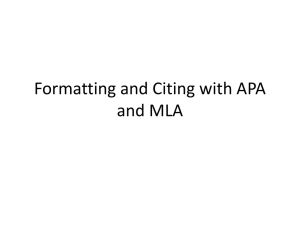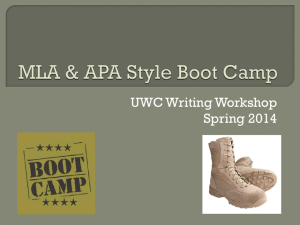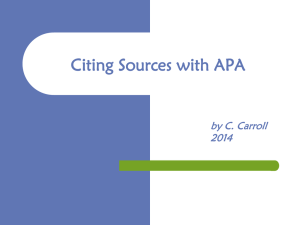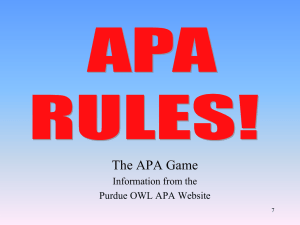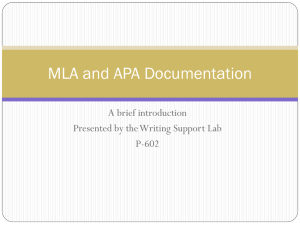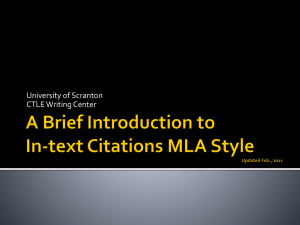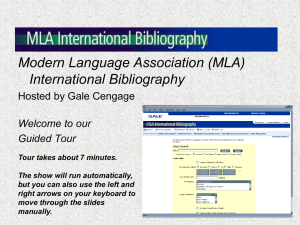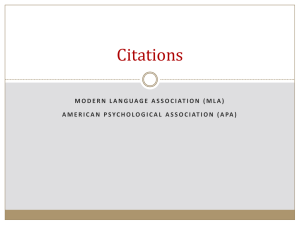An-Introduction-to-MLA-and-APA
advertisement
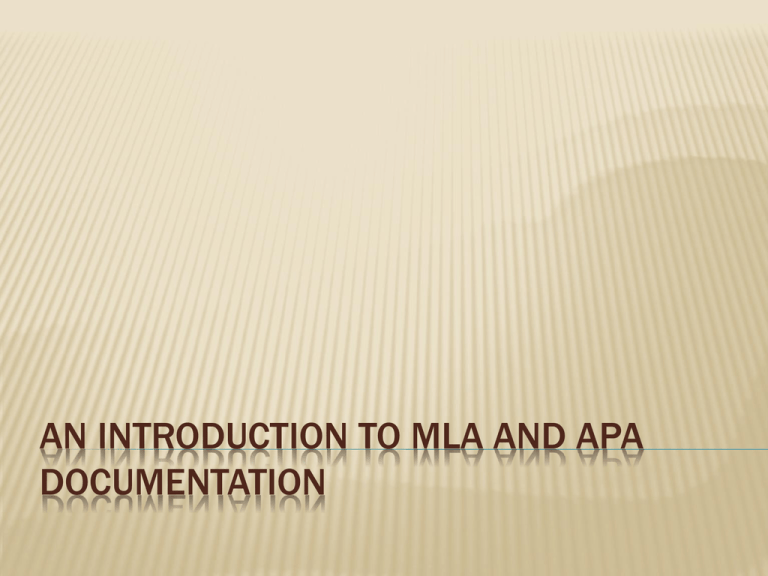
AN INTRODUCTION TO MLA AND APA DOCUMENTATION Part One: DOCUMENTATION BASICS WHAT IS DOCUMENTATION? When your teacher states that you must use APA or MLA documentation style, he or she is simply directing you to use a system that reveals to your reader what sources and information you have utilized in writing your paper. The documentation style also determines certain formatting practices in your paper. GENERAL PAPER FORMAT RULES Double space entire paper. Use 12 point, Times New Roman font Do not bold titles or the bibliography page heading Set all margins to 1” New paragraphs should be indented ½” from the margin PARTS OF DOCUMENTATION In-text (parenthetical) citation Bibliography (Works Cited Page, References) The in-text citation acts as a key to your bibliography and directs your reader to specific sources. The in-text citation includes the author’s last name (and/or) the title of the work so that you can easily locate the complete source information in the bibliography. IN-TEXT CITATIONS You need to give credit to a source any time you use information from the source in the following ways: Direct Quotation Paraphrase Summary TYPES OF QUOTATIONS Block Quotations – must be longer than three lines, set off from main body of paragraph (like a block) Integrated Quotations – three lines of text or fewer, flows seamlessly in the paragraph BLOCK QUOTATION FORMAT Indented 1” and double spaced Period comes at end of quote No quotation marks Citation follows the period INTEGRATED QUOTE FORMAT Quote integrated into paragraph Quotation mark precedes citation Quotation marks needed Period follows citation FORMATTING A PARAPHRASE OR SUMMARY The paraphrase or summary is in your own words and flows smoothly with the paragraph. The suggestion that there is a continuity in the linguistic abilities of apes and humans has created much controversy. Linguist Noam Chomsky has strongly asserted that language is a Period follows unique human characteristic citation. (Booth, 1990). Part Two: APA VS. MLA An Example of an APA Title Page •The header includes the running head (formatted as the following: Running head: TITLE OF ESSAY) against the left margin and the page number against the right margin. •The title of the essay, your name, and the university name should appear centered, double spaced, and on the top half of the page. •All text should be in 12 pt. Times New Roman font and should not be bolded. •Author’s note (optional) contains contact information and acknowledgements and should be placed at the bottom half of essay. MLA Sample First Page •MLA format does not require a title page. •On the first page, the student includes a heading (name, professor, course number and date). The first page heading begins on the first line of text (not the header) and is double spaced. •The title appears centered in plain text after the first page heading. •The header contains only the student’s last name and page number. MLA APA On each page after the title page, APA requires that the title appear in all caps on the left and the page number appears on the right. MLA format uses the same header (last name followed by page number in the right corner) for ever y page SUBSEQUENT PAGE HEADERS A QUICK EXERCISE Look at the Bibliography of the APA Model Paper and the MLA Model Paper and do the following tasks: List all the similarities do you see. List all the differences you see. SIMILARITIES Entries are double-spaced The first line of each entry begins at the margin. Subsequent lines display a ½” hanging indent. Entries are alphabetized by the first word in each entry (typically the author’s last name) The words “References” and “Works Cited” are both centered, at the top of the page, and in plain text. The important words in all journal titles and book titles are capitalized. DIFFERENCES MLA uses the heading “Works Cited” while APA refers to the page as “References.” In MLA entries the title follows the author’s name, but in APA, the year (in parentheses) follows the author’s name. Essay titles in MLA are put in quotation marks and all important words are capitalized. APA capitalizes only the first word of an essay’s title and does not put punctuation marks around the title. BIBLIOGRAPHY COMPARISON IN-TEXT CITATION DIFFERENCES Look at the in-text citations below and list the similarities and differences: APA Example: Obesity can be a devastating problem from both an individual and a societal perspective. Obesity puts children at risk for a number of medical complications, including Type 2 diabetes, hypertension, sleep apnea, and orthopedic problems (Henry J. Kaiser Family Foundation, 2004, p. 1). MLA Example: Frances Bents, an expert on the relation between cell phones and accidents, estimates that between 450 and 1,000 crashes a year have some connection to cell phone use (Layton C9). SIMILARITIES Both reveal the author’s name (or the title if the source is anonymous) Both reveal the page number where the information can be found if the source has page numbers listed IN-TEXT CITATIONS DIFFERENCES APA lists the year, but MLA does not A HELPFUL WEBSITE The Online Writing Lab at Purdue This website includes accurate guides to both MLA and APA format, annotated sample papers, examples of different types of works cited entries, and detailed information concerning punctuation, grammar, and other writing related topics.
